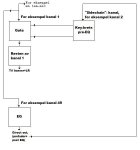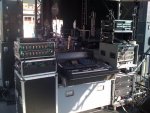Hello.
I'll be mixing monitors on a DM 2000 for the first time next month and I'm starting to plan out how to do this in the best manner and I'd appreciate your input.
Listening wedge: Is there a "control room" output or whatever that can be fed from to the solo bus to save me from connecting the listening wedge to the headphones output?
When cueing up mixes, is there a clever way to do this other than to just solo the AUX master in question? It would be cool to automatically bring up the same aux on faders as the one I'm listening to. So far, I was planning on using the four user layers and just putting the AUX masters in use first on every one so they're easy to get to, but it will take me a few pushes to: Solo correct aux > select input layer > select aux mode for faders> select correct aux > make the adjustment > repeat for next tweak, but I'll manage. (Can I even assign the same faders to more than one user layer bank? Perhaps my "home" should be the master layer for easy cueing of outputs?)
Do you normally have the auxes all set to post fader and the channel faders set to zero? This to quickly raise/lower something inn all auxes without fiddling with the gain control or "att".
Apart from that I was planning on controlling the actual mixing functions like I would from FOH otherwise using sends-on-faders.
How do you usually route FX in this situation?
Anything I've grossly overlooked?
Thank you very much in advance for any ideas.
Kristian Johnsen
I'll be mixing monitors on a DM 2000 for the first time next month and I'm starting to plan out how to do this in the best manner and I'd appreciate your input.
Listening wedge: Is there a "control room" output or whatever that can be fed from to the solo bus to save me from connecting the listening wedge to the headphones output?
When cueing up mixes, is there a clever way to do this other than to just solo the AUX master in question? It would be cool to automatically bring up the same aux on faders as the one I'm listening to. So far, I was planning on using the four user layers and just putting the AUX masters in use first on every one so they're easy to get to, but it will take me a few pushes to: Solo correct aux > select input layer > select aux mode for faders> select correct aux > make the adjustment > repeat for next tweak, but I'll manage. (Can I even assign the same faders to more than one user layer bank? Perhaps my "home" should be the master layer for easy cueing of outputs?)
Do you normally have the auxes all set to post fader and the channel faders set to zero? This to quickly raise/lower something inn all auxes without fiddling with the gain control or "att".
Apart from that I was planning on controlling the actual mixing functions like I would from FOH otherwise using sends-on-faders.
How do you usually route FX in this situation?
Anything I've grossly overlooked?
Thank you very much in advance for any ideas.
Kristian Johnsen
Last edited:


